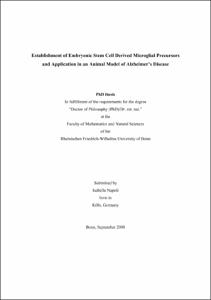Establishment of Embryonic Stem Cell Derived Microglial Precursors and Application in an Animal Model of Alzheimer’s Disease

Establishment of Embryonic Stem Cell Derived Microglial Precursors and Application in an Animal Model of Alzheimer’s Disease

| dc.contributor.advisor | Neumann, Harald | |
| dc.contributor.author | Napoli, Isabella | |
| dc.date.accessioned | 2020-04-12T19:53:05Z | |
| dc.date.available | 2020-04-12T19:53:05Z | |
| dc.date.issued | 2008 | |
| dc.identifier.uri | https://hdl.handle.net/20.500.11811/3717 | |
| dc.description.abstract | The role of microglia in Alzheimer’s disease (AD) is controversial, as it remains unclear if the microglia form the amyloid fibrils or react to them in a phagocytic role. However, there has been recognition that microglia may also play a neuroprotective role through phagocytosis of Aβ. To study microglial function, primary microglia are typically derived from mixed glial cultures from early postnatal brain tissue. Isolation of such primary microglia is time consumable and inefficient due to low cell yield. To overcome these limitations we established a reproducible procedure to differentiate mouse ES cells into the desired microglial cells. In this work, two distinct ES cell lines were differentiated into microglial precursor cells by a method allowing differentiation of embryoid bodies to microglia within a mixed brain culture. Several independent microglial precursor (ESdM) lines were generated from the ES cells and characterized by flow cytometry, immunocytochemistry and functional assays. All ESdM showed expression of IBa1, CD11b, CD45, F4/80, α4 integrin and β1 integrin, but were negative for cKit and CD34. Furthermore, stimulation with interferon-γ (IFNγ) or lipopolysaccharides (LPS) demonstrated up-regulation of pro-inflammatory mediator gene transcription including nitric oxide synthase-2 (iNOS), interleukin-1β (IL1β) and tumor necrosis factor-α (TNFα) at levels comparable to primary microglia. ESdM showed efficient and rapid phagocytosis of amyloid-β (Aβ) peptide, which was increased after stimulation with LPS. ESdM expressed the chemokine receptor CX3CR1 and demonstrated concentration dependent migration towards its ligand CX3CL1. After in vivo transplantation into postnatal brain tissue ESdM showed engraftment as cells with a microglial phenotype and morphology. The therapeutic application of ESdM was assessed in an animal model of AD (APP23). To overexpress GFP, ESdM were lentivirally transduced and locally injected to the cortex of APP23 mice. Immunohistochemistry showed that ESdM were able to contribute beneficially to a clearance of Aβ at the transplantation site resulting in a significant decreased total plaque area as well as in smaller plaques. In summary, ESdM are stable proliferating cells substantially having most characteristics of primary microglia and therefore being a suitable tool to study microglial function and to use them as a source for cell therapy applications. | en |
| dc.language.iso | eng | |
| dc.rights | In Copyright | |
| dc.rights.uri | http://rightsstatements.org/vocab/InC/1.0/ | |
| dc.subject | Microglia | |
| dc.subject | Embryonic Stem Cell | |
| dc.subject | Alzheimer | |
| dc.subject | Inflammation | |
| dc.subject.ddc | 570 Biowissenschaften, Biologie | |
| dc.title | Establishment of Embryonic Stem Cell Derived Microglial Precursors and Application in an Animal Model of Alzheimer’s Disease | |
| dc.type | Dissertation oder Habilitation | |
| dc.publisher.name | Universitäts- und Landesbibliothek Bonn | |
| dc.publisher.location | Bonn | |
| dc.rights.accessRights | openAccess | |
| dc.identifier.urn | https://nbn-resolving.org/urn:nbn:de:hbz:5N-16243 | |
| ulbbn.pubtype | Erstveröffentlichung | |
| ulbbnediss.affiliation.name | Rheinische Friedrich-Wilhelms-Universität Bonn | |
| ulbbnediss.affiliation.location | Bonn | |
| ulbbnediss.thesis.level | Dissertation | |
| ulbbnediss.dissID | 1624 | |
| ulbbnediss.date.accepted | 09.12.2008 | |
| ulbbnediss.fakultaet | Mathematisch-Naturwissenschaftliche Fakultät | |
| dc.contributor.coReferee | Kolanus, Waldemar |
Files in this item
This item appears in the following Collection(s)
-
E-Dissertationen (4397)




